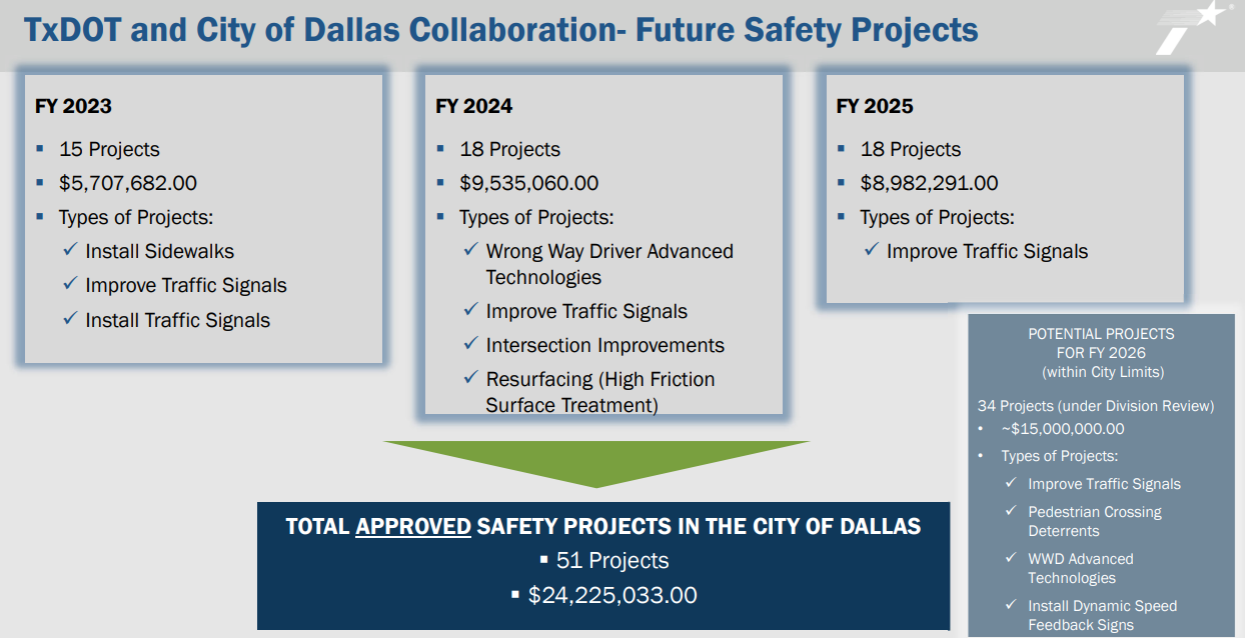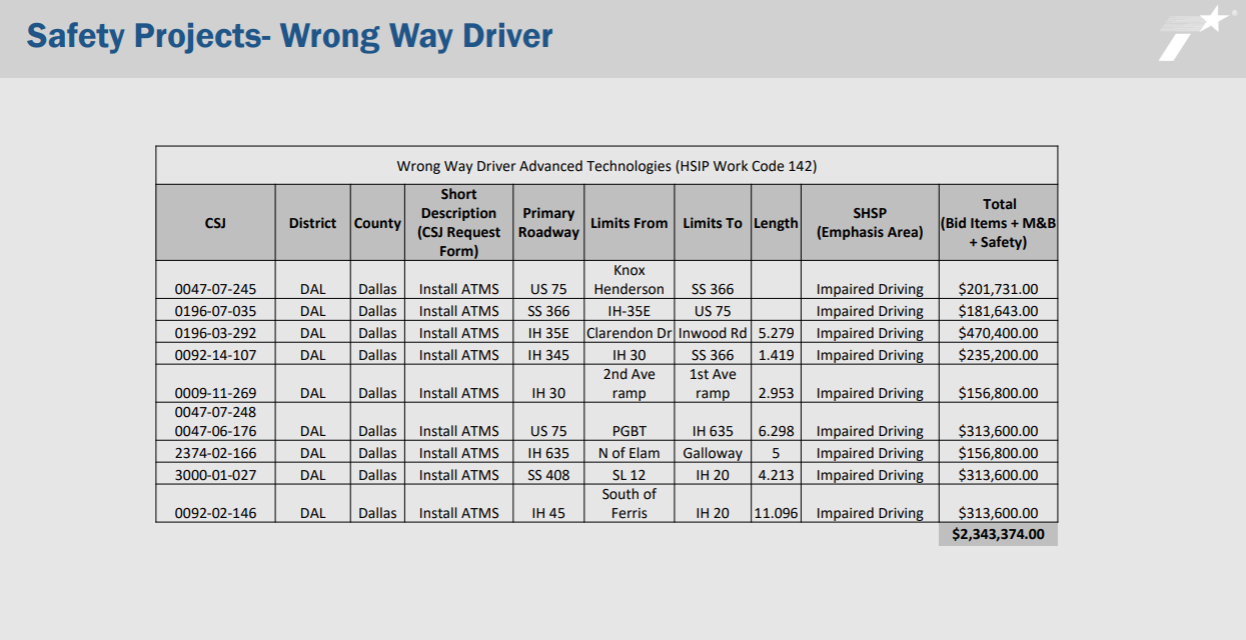It’s been nearly 23 years since Texas went a day without a traffic fatality. Less than four months into 2023, 36 people have died following vehicular accidents in Dallas. On Monday, the City Council’s Transportation and Infrastructure Committee heard from the Texas Department of Transportation on how the two entities might work together to reduce that number.
Last year, the city adopted its Vision Zero plan, which has a goal to reduce deaths from crashes to zero by 2030. It also wants to see a 50 percent reduction in severe injuries. TxDOT has a similar plan to reduce traffic fatalities to zero by 2050, and by half by 2035.
To help with those efforts, TxDOT plans on spending at least $24 million on 51 safety projects over the next three years in the city of Dallas. Another 34 projects with a price tag of at least $15 million are being reviewed for 2026.
The city and the state have their work cut out for them. TxDOT district engineer Ceason Clemens told the committee that countywide, there were 324 fatal crashes in 2022 and 326 in 2021. Dallas County saw its biggest leap in fatalities from 2019 to 2020, where they increased from 257 to 307.
“The good news is the trend is starting to level out,” she said. Speeding, she said, is the No. 1 contributing factor in county traffic fatalities, with driving under the influence second.
Statewide, Clemens said that between 2019 and 2022, almost half of all fatalities involved victims not wearing seatbelts. Roughly 35 percent were speed related, and 30 to 35 percent involved impaired motorists. Pedestrians accounted for almost 20 percent of all traffic fatalities in Texas.
The time of day also factored into the frequency of crashes and fatalities. In 2022, 55 percent of all fatal crashes happened overnight statewide, while 70 percent of all crashes happened during working hours—from 7 a.m. to 7 p.m.
Locally, those numbers look similar, according to the city’s Vision Zero dashboard. Dallas saw a slight decrease in severe injury crashes from 2021 to 2022, dropping from 1,098 to 1,029. Fatalities rose by two during that same time frame, from 216 to 218. Most fatal and severe injury crashes are happening on Saturday and Sunday nights, between 12 a.m. and 3 a.m., with the second largest cluster on Friday and Saturday nights between 6 p.m. and 12 a.m. So far, there have been 6,720 total crashes reported this year.
TxDOT compiles a lot of data on crashes, and then uses that data to help determine whether engineering, driver education, or other responses could improve the odds that a driver’s commute won’t end in a fatality.
“We look at all these emphasis areas to see if there’s something on our roadways that we could change and hopefully make it a more forgiving roadway,” Clemens said. “But a lot of it is driver behavior.”
TxDOT is spending on projects it says will help improve safety on the Dallas County roads for which it is responsible. This includes placing rumble strips on every road (“we used to only install them in rural areas,” Clemens said) as well as improving road barriers, pavement markings, traffic signals, and courtesy patrols. This year, TxDOT has approved projects that would add sidewalks, improve traffic signals, and install new traffic signals in targeted areas of the city identified by crash data.
The agency also plans to hopefully slow down speeders by installing dynamic speed signs that would warn drivers of how fast they’re going. Councilwoman Gay Donnell Willis questioned how effective those signs are over time, but Clemens said they have proven to be at least a short-term deterrent.
“As far as effectiveness, at the end of the day, it’s gotta be enforced,” she said of the speed limits. “So that’s going to require your law enforcement, too.”
Deputy Mayor Pro Tem Omar Narvaez and Councilwoman Jaynie Schultz expressed concerns about pedestrians that often attempt to cross Northwest Highway and other busy roadways without using crosswalks. Clemens said that part of TxDOT’s plans for both Northwest Highway and Preston Road would be firmed up after a traffic study it is conducting with the North Central Texas Council of Governments. Statistically, many of the pedestrian fatalities involve people crossing “mid-block” instead of at the crosswalks, she said.
“We are wrapping that up soon, and we have a variety of options to address it,” she said. “A lot of it is intersection improvements. Can we add turn lanes? Can we make the pedestrian crossing safer and more inviting?”
The agency is also planning to spend $2.3 million on improvements that it hopes will cut down on wrong-way driver accidents. TxDOT has identified nine areas in Dallas County where it will make those improvements, which will include better signage, reflecting pavement markings that display red if a driver is going the wrong way, and strobe lights that would alert a driver that they are going the wrong way while allowing TxDOT’s traffic management team to contact local law enforcement to intervene.
Those nine spots that the agency has identified include access roads that include U.S. 75 from Knox Henderson to Woodall Rogers, I-35E from Clarendon Dr. to Inwood Rd., I-345 from I-30 to Woodall Rodgers, and I-30 from the 2nd Ave. ramp to the 1st Ave. ramp. Those projects are part of the $9.5 million allocated for 2024.
Obviously, there are far more roads in Dallas that aren’t the responsibility of TxDOT. The city will need to address those issues, and how it enforces traffic laws. Already, the city has identified what it calls its High Injury Network of roads where motorists frequently end up in accidents. By the end of this year, for instance, city staff expects to have completed a citywide evaluation of speed limits and make recommendations for changes to the City Council.
The Vision Zero plan includes measures like road diets, speed cushions, and improved and new pedestrian crossings that help protect people on two feet by getting drivers to slow down. The city is also working to fund sidewalk improvements in priority areas.
Get the D Brief Newsletter
Author






